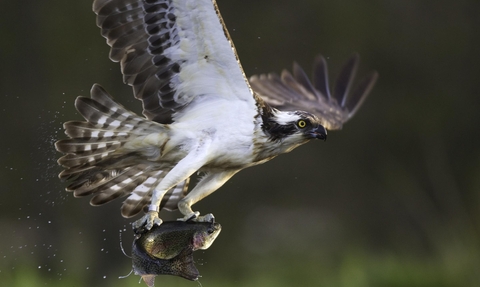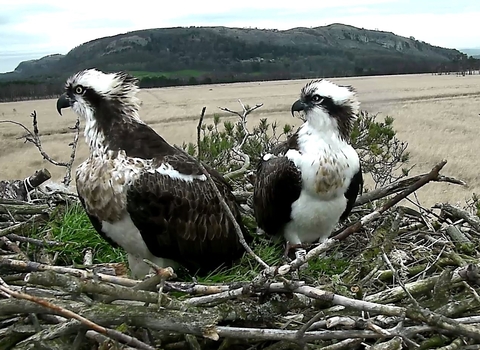
Osprey (pandion haliaetus) fishing, Cairngorms National Park, Scotland © Peter Cairns/2020Vision
Osprey
Osprey bird of prey, scientific name: Pandion haliaetus
A great way to get up close and personal to an osprey is via our osprey webcam at our Foulshaw Moss Nature Reserve. The osprey is a spring
Our conservation work to restore Foulshaw Moss Nature Reserve has encouraged ospreys to visit since the late 1990s. Improvements to the habitat and the installation of a number of nesting platforms now provides the ideal location for ospreys to nest and to breed, and for many other species too.
In 2014, for the first time, a pair of osprey successfully bred and reared three healthy chicks. Foulshaw Moss is next to the Kent Estuary as well as near the rivers, lakes and tarns, giving the birds options of where to fish.
With more hard work and more habitat improvements we hope that ospreys will become a more common sight across the whole of the UK.
If you time your visit to Foulshaw Moss Nature Reserve when staff are present there is usually a telescope focused on the nest so you can get a view of the nest.
Category
Statistics
Length: 56cm
Wingspan: 1.6m
Weight: 1.5kg
Average lifespan: 9 years
Conservation Status
The Osprey is classified in the UK as Amber under the Birds of Conservation Concern 5: the Red List for Birds (2021). Protected in the UK under the Wildlife and Countryside Act, 1981.
Osprey diet
Ospreys eat fish, hunting for them in lakes and lochs, stretching out their talons and scooping their catch out of the water.
How to identify an osprey
The osprey is a brown-and-white bird which could possibly be mistaken for a seagull at a distance. The osprey is a large bird of prey with dark brown upperparts and contrasting white underparts that can appear mottled in females.
Their heads are white with a dark brown through their eyes. Their wings during flight show strong barring and distinctively dark brown, angled ‘wrists’.
Distribution
Nests in parts of Scotland, Cumbria, the East Midlands and Wales. Ospreys can also be spotted at large waterbodies across the country during migration.
Habitats
Did you know?
Ospreys migrate to West Africa during winter; satellite tracking has shown them flying up to 430 km in just one day. It takes them about 20 flying days to complete the journey, but, in autumn, birds stop off to refuel at lakes and reservoirs.

Osprey nest
Watch the osprey family, in their nest and roost tree, at Foulshaw Moss Nature Reserve. They're usually here between March to early September.







